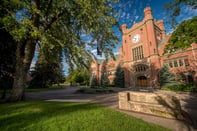Published on
Adapting to the Challenges of Today’s Postsecondary Environment

The higher education environment is in a state of flux. Institutions today have a wide and complex set of challenges to solve that weren’t even imagined 20 years ago, putting leaders under enormous amounts of pressure. However, institutions and leaders that are truly innovative—those that see the challenges of today’s marketplace as opportunities—will be able to succeed and thrive with the right tools at their disposal. In this interview, Jay Halfond outlines some of the most critical challenges facing today’s postsecondary leaders and shares his thoughts on how institutions might navigate these issues.
The EvoLLLution (Evo): What are the most significant challenges higher education leaders can expect to face in the coming years?
Jay Halfond (JH): The list of challenges, it seems, gets longer each day. The college presidency used to be a somewhat genteel, low-stress job, highly respected with mostly ceremonial duties that celebrated the achievements of faculty and students. Now it has become one of the more impossible, thankless, unenviable positions no matter how well paid.
At no time has the academic presidency been more under siege. In the 1960s, Clark Kerr would speak about how the multiversity president had to be a jack-of-all-trades. What he thought seemed like an extensive mix of talents seems in retrospect almost quaint. Today, the pressures have expanded to include racial equality, challenges to free speech, calls from legislators and trustees for tougher and more decisive leadership, faculty seeking protection for their resources and endeavors, a public looking for quick payback for their deep investment in a college degree, corruption in big-time athletics, loss of government funding coupled with rising public control, and the list goes on and on.
Contemporary college and university presidents are in the perennial hot seat—and their visibility only exposes their vulnerability—to votes of no confidence, calls for resignations, and second-guessing from a host of stakeholders. Presidents are challenged publicly to act forcefully, but risk alienating yet another vocal constituency when they do so—assuming they even have the power to effect change.
Evo: Is there a particular institution type (i.e.: public, private not-for-profit, for-profit) that is more susceptible to these challenges than others? If so, why?
JH: Each sector faces its own unique blend of these pressures. Smaller, more local institutions have fewer degrees of freedom and levers to pull—and, as a result, might be fighting for their very survival. Those more major institutions are struggling to raise or protect their rankings, where perhaps over one hundred schools believe they deserve to be in the top twenty. Public institutions are in search of new sources of revenue, and how to raise productivity without provoking revolution. Private, non-profits are often caught in a spiral where prestige entails even more expense. For-profits pray for someone in the White House who will protect their federal source of funds and ignore their accountability. Major universities dread the day when they are held responsible for lifelong football injuries and ways they’ve exploited black athletes.
Evo: What are a few of the trends and approaches institutions can take advantage of to overcome (or at least weather) these challenges?
JH: I am not necessarily pessimistic. I think we are in the midst of one of the most exciting times in the history of American higher education. But what makes it exciting also suggests major controversy and upheaval. I believe we face a serious redistribution of students. Where some schools will be innovative enough to grow and thrive, others will be paralyzed and risk decline, merger or closure. To be impactful, this redistribution doesn’t need to be cataclysmic. The winners are likely to be those who find imaginative ways to energize their institutions, better attract and educate students, and demonstrate their value and quality to an increasingly skeptical public.
Some of the opportunities for responsible change continue to be how universities attract and integrate students from abroad. In my view, internationalization of the student body has been driven more by the need for financial contribution than for their contribution towards diversifying the student campus experience. We need to think of foreign students as assets to integrate into the mainstream rather than just revenue units.
We also need to think of faculty careers more comprehensively and appreciate the cost, along with the importance of scholarship, and accept the reality that we need a balance and variety of appropriately rewarded faculty talents throughout the enterprise. An exploited example has been the ever-growing numbers of adjunct faculty who are now exerting power through unionization.
Evo: What are a few of the most significant obstacles leaders must overcome to implement institutional changes? How can they be overcome?
JH: It is tempting to bash faculty as the chief impediments to change. This, in my mind, is unfair. Professors have come a long way this past decade by introducing digital technology into their teaching, and demonstrating far more receptivity to online learning than often recognized. Their skepticism towards MOOCs and other panaceas has proven to be more thoughtful than reactionary.
One obstacle has been the poor ways in which colleges have conveyed the importance of the liberal arts. The escalating cost of higher education has accelerated the pressures to show the tuition ROI. This, in turn, has raised serious questions about the value of non-vocational learning. In my view, it is dangerous and even corrupting to proceed down a path that shows that higher education ensures lucrative jobs soon after graduation. But we need to do a far better job demonstrating the relevance of a broad, general education, while linking what we teach to what is critical in the professional world.
Evo: What role do you think continuing education and extension divisions need to play in order to help their institutions overcome these challenges?
JH: What we call continuing education (which covers quite a span of possibilities) is at a key inflection point. We can become a major part of the solution—and perhaps even the best friend of the besieged academic president. But this requires a makeover at many institutions.
Continuing educators have to earn a seat at the table and show that they bring assets and answers to what their schools need to transform themselves. In the past, this has been more financial than strategic. But it will need to be far broader in the future. Continuing educators are in a unique position to bring greater student access to their institutions—by enhancing the generational, geographic, ethnic, international, and socio-economic mix of students. This would be diversity writ large as schools go beyond rhetoric to the reality of a truly melting pot educational experience. Continuing educators can help discover new curricular and pedagogical models in the process–and new ways to attract and accommodate students, better utilize faculty, and create integrated, holistic experiences for their students. In short, continuing education needs to emphasis the word “education” in all its work.
What is at stake is the American Dream. For so long, higher education enjoyed a position as a catapult for opportunity, for those with the drive and intellect to use their education towards greater accomplishments. Now universities are seen as means by which the well off solidify their hold on the upper ranks of our society. If we are going to reassert the idealistic role of our academic institutions as a means for overcoming adversity and achieving success, this likely will be through the important work of continuing educators.
Author Perspective: Educator



